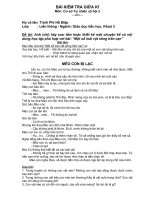- Trang chủ >>
- Nông - Lâm - Ngư >>
- Thú y
Động Vật Sống Trên Cạn
Bạn đang xem bản rút gọn của tài liệu. Xem và tải ngay bản đầy đủ của tài liệu tại đây (1.89 MB, 37 trang )
<span class='text_page_counter'>(1)</span><div class='page_container' data-page=1>
© 2007 Cisco Systems, Inc. All rights reserved. Cisco Public 1
Version 4.0
Addressing the Network
– IPv4
</div>
<span class='text_page_counter'>(2)</span><div class='page_container' data-page=2>
2
© 2007 Cisco Systems, Inc. All rights reserved. Cisco Public
<b>Objectives</b>
<sub>Explain the structure IP addressing and demonstrate the ability </sub>
to convert between 8-bit binary and decimal numbers.
<sub>Given an IPv4 address, classify by type and describe how it is </sub>
used in the network.
<sub>Explain how addresses are assigned to networks by ISPs and </sub>
within networks by administrators.
<sub>Determine the network portion of the host address and explain </sub>
the role of the subnet mask in dividing networks.
<sub>Given IPv4 addressing information and design criteria, calculate </sub>
the appropriate addressing components.
<sub>Use common testing utilities to verify and test network </sub>
</div>
<span class='text_page_counter'>(3)</span><div class='page_container' data-page=3>
3
© 2007 Cisco Systems, Inc. All rights reserved. Cisco Public
<b>IP Addressing Structure</b>
<sub>Describe the dotted decimal structure of a binary IP </sub>
</div>
<span class='text_page_counter'>(4)</span><div class='page_container' data-page=4>
4
© 2007 Cisco Systems, Inc. All rights reserved. Cisco Public
<b>IP Addressing Structure</b>
<sub>Describe the general role of 8-bit binary in network </sub>
</div>
<span class='text_page_counter'>(5)</span><div class='page_container' data-page=5>
5
© 2007 Cisco Systems, Inc. All rights reserved. Cisco Public
<b>IP Addressing Structure</b>
</div>
<span class='text_page_counter'>(6)</span><div class='page_container' data-page=6>
6
© 2007 Cisco Systems, Inc. All rights reserved. Cisco Public
<b>IP Addressing Structure</b>
</div>
<span class='text_page_counter'>(7)</span><div class='page_container' data-page=7>
7
© 2007 Cisco Systems, Inc. All rights reserved. Cisco Public
<b>IP Addressing Structure</b>
</div>
<span class='text_page_counter'>(8)</span><div class='page_container' data-page=8>
8
© 2007 Cisco Systems, Inc. All rights reserved. Cisco Public
<b>Classify and Define IPv4 Addresses</b>
<sub>Name the three types of addresses in the network and </sub>
</div>
<span class='text_page_counter'>(9)</span><div class='page_container' data-page=9>
9
© 2007 Cisco Systems, Inc. All rights reserved. Cisco Public
<b>Classify and Define IPv4 Addresses</b>
<sub>Determine the network, broadcast and host addresses </sub>
</div>
<span class='text_page_counter'>(10)</span><div class='page_container' data-page=10>
10
© 2007 Cisco Systems, Inc. All rights reserved. Cisco Public
<b>Classify and Define IPv4 Addresses</b>
<sub>Name the three types of communication in the Network </sub>
</div>
<span class='text_page_counter'>(11)</span><div class='page_container' data-page=11>
11
© 2007 Cisco Systems, Inc. All rights reserved. Cisco Public
<b>Classify and Define IPv4 Addresses</b>
<sub>Identify the address ranges reserved for these special </sub>
</div>
<span class='text_page_counter'>(12)</span><div class='page_container' data-page=12>
12
© 2007 Cisco Systems, Inc. All rights reserved. Cisco Public
<b>Classify and Define IPv4 Addresses</b>
</div>
<span class='text_page_counter'>(13)</span><div class='page_container' data-page=13>
13
© 2007 Cisco Systems, Inc. All rights reserved. Cisco Public
<b>Classify and Define IPv4 Addresses</b>
</div>
<span class='text_page_counter'>(14)</span><div class='page_container' data-page=14>
14
© 2007 Cisco Systems, Inc. All rights reserved. Cisco Public
<b>Classify and Define IPv4 Addresses</b>
<sub>Identify the historic method for assigning addresses and </sub>
</div>
<span class='text_page_counter'>(15)</span><div class='page_container' data-page=15>
15
© 2007 Cisco Systems, Inc. All rights reserved. Cisco Public
<b>Assigning Addresses</b>
<sub>Explain the importance of using a structured process to </sub>
</div>
<span class='text_page_counter'>(16)</span><div class='page_container' data-page=16>
16
© 2007 Cisco Systems, Inc. All rights reserved. Cisco Public
<b>Assigning Addresses</b>
<sub>Explain how end user devices can obtain addresses </sub>
</div>
<span class='text_page_counter'>(17)</span><div class='page_container' data-page=17>
17
© 2007 Cisco Systems, Inc. All rights reserved. Cisco Public
<b>Assigning Addresses</b>
<sub>Explain which types of addresses should be assigned </sub>
</div>
<span class='text_page_counter'>(18)</span><div class='page_container' data-page=18>
18
© 2007 Cisco Systems, Inc. All rights reserved. Cisco Public
<b>Assigning Addresses</b>
<sub>Describe the process for requesting IPv4 public </sub>
</div>
<span class='text_page_counter'>(19)</span><div class='page_container' data-page=19>
19
© 2007 Cisco Systems, Inc. All rights reserved. Cisco Public
<b>Assigning Addresses</b>
<sub>Identify different types of ISPs and their roles in </sub>
</div>
<span class='text_page_counter'>(20)</span><div class='page_container' data-page=20>
20
© 2007 Cisco Systems, Inc. All rights reserved. Cisco Public
<b>Assigning Addresses</b>
<sub>Identify several changes made to the IP protocol in </sub>
</div>
<span class='text_page_counter'>(21)</span><div class='page_container' data-page=21>
21
© 2007 Cisco Systems, Inc. All rights reserved. Cisco Public
<b>Determine the network portion of the host address and </b>
<b>the role of the subnet mask </b>
<sub>Describe how the subnet mask is used to create and </sub>
</div>
<span class='text_page_counter'>(22)</span><div class='page_container' data-page=22>
22
© 2007 Cisco Systems, Inc. All rights reserved. Cisco Public
<b>Determine the network portion of the host address and </b>
<b>the role of the subnet mask </b>
<sub>Use the subnet mask and ANDing process to extract </sub>
</div>
<span class='text_page_counter'>(23)</span><div class='page_container' data-page=23>
23
© 2007 Cisco Systems, Inc. All rights reserved. Cisco Public
<b>Determine the network portion of the host address and </b>
<b>the role of the subnet mask </b>
</div>
<span class='text_page_counter'>(24)</span><div class='page_container' data-page=24>
24
© 2007 Cisco Systems, Inc. All rights reserved. Cisco Public
<b>Determine the network portion of the host address and </b>
<b>the role of the subnet mask </b>
<sub>Observe the steps in the ANDing of an IPv4 host </sub>
</div>
<span class='text_page_counter'>(25)</span><div class='page_container' data-page=25>
25
© 2007 Cisco Systems, Inc. All rights reserved. Cisco Public
<b>Calculating Addresses </b>
<sub>Use the subnet mask to divide a network into smaller </sub>
</div>
<span class='text_page_counter'>(26)</span><div class='page_container' data-page=26>
26
© 2007 Cisco Systems, Inc. All rights reserved. Cisco Public
<b>Calculating Addresses </b>
<sub>Extract network addresses from host addresses using </sub>
</div>
<span class='text_page_counter'>(27)</span><div class='page_container' data-page=27>
27
© 2007 Cisco Systems, Inc. All rights reserved. Cisco Public
<b>Calculating Addresses </b>
<sub>Calculate the number of hosts in a network range given </sub>
</div>
<span class='text_page_counter'>(28)</span><div class='page_container' data-page=28>
28
© 2007 Cisco Systems, Inc. All rights reserved. Cisco Public
<b>Calculating Addresses </b>
<sub>Given a subnet address and subnet mask, calculate the </sub>
</div>
<span class='text_page_counter'>(29)</span><div class='page_container' data-page=29>
29
© 2007 Cisco Systems, Inc. All rights reserved. Cisco Public
<b>Calculating Addresses </b>
<sub>Given a pool of addresses and masks, assign a host </sub>
</div>
<span class='text_page_counter'>(30)</span><div class='page_container' data-page=30>
30
© 2007 Cisco Systems, Inc. All rights reserved. Cisco Public
<b>Calculating Addresses </b>
<sub>Given a diagram of a multi-layered network, address </sub>
range, number of hosts in each network and the ranges
for each network, create a network scheme that
</div>
<span class='text_page_counter'>(31)</span><div class='page_container' data-page=31>
31
© 2007 Cisco Systems, Inc. All rights reserved. Cisco Public
<b>Testing the Network Layer </b>
<sub>Describe the general purpose of the ping command, </sub>
</div>
<span class='text_page_counter'>(32)</span><div class='page_container' data-page=32>
32
© 2007 Cisco Systems, Inc. All rights reserved. Cisco Public
<b>Testing the Network Layer </b>
<sub>Use ping to verify that a local host can communicate </sub>
</div>
<span class='text_page_counter'>(33)</span><div class='page_container' data-page=33>
33
© 2007 Cisco Systems, Inc. All rights reserved. Cisco Public
<b>Testing the Network Layer </b>
<sub>Use ping to verify that a local host can communicate via </sub>
</div>
<span class='text_page_counter'>(34)</span><div class='page_container' data-page=34>
34
© 2007 Cisco Systems, Inc. All rights reserved. Cisco Public
<b>Testing the Network Layer </b>
<sub>Use tracert/traceroute to observe the path between two </sub>
</div>
<span class='text_page_counter'>(35)</span><div class='page_container' data-page=35>
35
© 2007 Cisco Systems, Inc. All rights reserved. Cisco Public
<b>Testing the Network Layer </b>
<sub>Describe the role of ICMP in the TCP/IP suite and its </sub>
</div>
<span class='text_page_counter'>(36)</span><div class='page_container' data-page=36>
36
© 2007 Cisco Systems, Inc. All rights reserved. Cisco Public
</div>
<span class='text_page_counter'>(37)</span><div class='page_container' data-page=37>
37
</div>
<!--links-->









